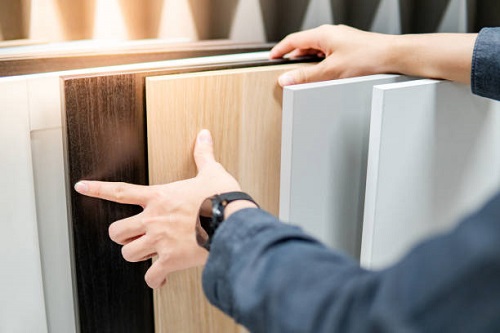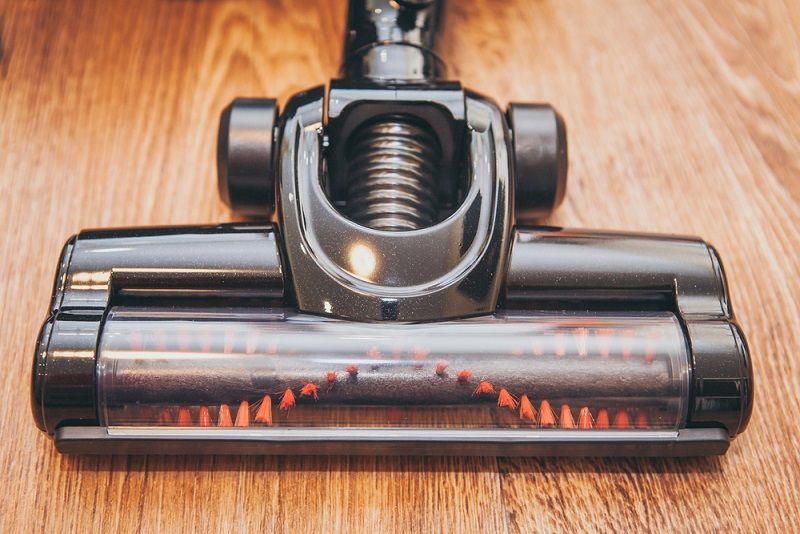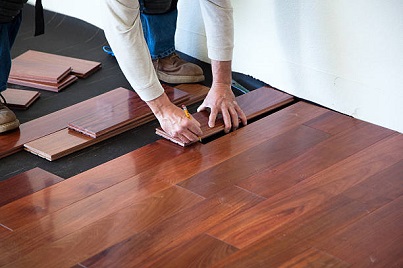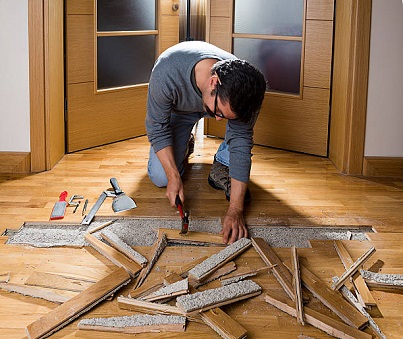by Liz Gonzales
Almost every first-time homeowner and remodeler find it hard to choose which flooring material to go with. The market has seen the hot trend of hardwood flooring to gain momentum daily. While it is hard to notice, there are different hardwood floor types including the prevalent laminate and engineered hardwood.
Although the two are popular alternatives right now, they have similar looks and structure. Consumers often end up confusing them while in need without noticing any key differences. Below is a clarification to help you decide quickly.
Contents


Engineered hardwood has a piece of wood on the top surface. This gives the natural look when used on floors. Always known as man-made or manufactured wood, it was initially made to help overcome the weak points of regular wood. For instance, it addresses well issues like susceptibility to dampness and warping.
Although this type of floor looks like a solid plank since it is thicker. It consists of many compressed layers. It has two components including 3 to 12 fiberboard, plywood, or unfinished hardwood at the core and bottom part. Then there is a thin coating of veneer on top that makes it nearly hard to distinguish from real hardwood.
Not only does this option come with thinner looks but also it provides an attractive exotic traditional flooring. Keeping in mind that it is prone to being dull like other natural woods, it is vital to properly clean it and perform regular maintenance. That means you get to enjoy its durability.
On the other end, laminate has a photographic coating that is treated with another protecting film. It seems much thinner than engineered hardwood, with an average of about 12mm. Basically, the laminate floor is rigid and synthetic thus also called Pergo, composite, or floating plank tile.
It has several compressed materials that appear to be in layers. The bottommost layer works as the base and helps in resisting moisture. Its innermost core constitutes a high-density fiber sheet supported using resin. The photographic layer is the visible and high-grade appearance that at times comes textured. The protective layer on top is also clear and coated towards the photographic film to protect it from any damages.
Its photographic layer comes in several different types and woodcuts. Thanks to the innovative technologies, it is easy to mimic real hardwood looks. Of course, the glossiness comes regardless of the organic materials supplied in the manufacturing sector
Both floor options have attractive effects, either authentic or synthetic looks. Thus, homeowners must decide not only what is required but also something cost-effective.
Both engineered hardwood and laminate flooring have a range of prices. The structures vary from inexpensively priced to luxurious classes. Usually, there will be a rise depending on the level of AC ratings, additional technology, leak protection, and surface qualities for laminates.
The rates of engineered flooring options often become higher following the veneer thickness on the top wood, style, wood species used, and brand. So, in case budget-friendliness has a vital role during your decision-making process compare between the two and settle for something that will not break your bank. Generally, like other sectors, the case here is that you will always find what suits your needs.
But it does not harm if you go ahead to weigh all the factors before the last decision. You can further consult for guidance if you find it hard to tell what significantly costs less.

Without doubts, while investing in a flooring option, the ease to clean is an important aspect. As far as it the most commonly used area in the home, you will not want to keep following complex care guides. This is frustrating because if you miss something it means you have compromised on quality. Well, both types of flooring need regular maintenance methods including sweeping, vacuuming and even immediate cleaning of spills.
Engineered hardwoods are usually smooth enough so do not easily trap dirt and other allergens. This makes it easily and quickly cleaned even with just a wet mop or a special cleaner. Caring is done like it is for the traditional hardwoods. If possible, it must be swept, regularly vacuumed and kept without stagnant water or scratches. Considering periodic polishing or refinishing is essential to keep its original shape. Since some wood varieties come with irregularities or holes, it is good to pay more attention to the areas while cleaning.
Alternatively, laminates are resistant to stains from household elements, like coffee or red wine, among others. Unlike engineered hardwoods, any spills or chemicals will not affect this type of flooring adversely. The included hardwood veneer layer is protective enough and makes it smooth. Thus, you can easily wipe it to clean.
Besides, it never traps dust in comparison to carpets. This quality makes it excellently fit for homes having people with allergies. Its wear layer does not scratch easily as most natural materials do. So, you will not need to pad your furniture and move them around without the fear of causing damage. Cleaning the floor also needs special products that are not harsh but can protect its layer from premature wear.
If both are improperly cleaned, then that will shorten the floor’s layer life. So, it is recommended to follow the manufacturer-accepted cleaning ways and products.
Both Engineered Hardwoods and laminates are manufactured in similar ways. Although they consist of different products the products are very durable. That guarantees that the flooring options are fit for use in busy businesses and homes having heavy foot traffic.
Laminates have Aluminum Oxide on the surface to protect from fading, stains, spills, and scratching. The compressed and wear layer on top makes it tough enough and long-lasting. It stays in good shape for 10 to 20 years then replacement will be necessary.
Engineered Wood on the other side is specifically made as an upgraded type of hardwood. That means it is durable and very water-resistant to withstand sudden happenings. Depending on the thickness of the veneer layer, you can refinish is a few more times. This improvement will help extend its lifetime.
However, the design from natural products makes it completely susceptible to moisture destruction and even rot. With decent care routines, the product will last between 20 to 100 years. Although this is determined by the wood quality used.
The main difference between the durability of engineered hardwood ad laminates comes on its surface roughness.

Both laminate and engineered hardwood flooring are friendly to DIY tasks. All you need is to click and then lock during installation. The friendliness comes from the fact that the flooring options are thin, light in weight, and so can interlock well with other boards. The pieces are easily floated on existing floors reducing the need to remove the bottom floor.
Laminate can get installed within a single day. If mounted on top of a concrete slab, there is a need to add some moisture-proof layer. Installing it over other subfloors is simple and possible except for a carpet.
The latest versions of engineered hardwood floors have a plank that interlocks with a click and snaps. That way the DIY installation is possible on any subfloor using the right tools on a structurally stable floor. Remember using thicker material presents complications if you have little experience.
Excess moisture is a danger to wood products. Unfortunately, none of the flooring options is waterproof even if properly installed. But homeowners appreciate the fact that both are known to be water-resistant. Both floors need a moisture barrier to add protect the subfloor further.
Laminate needs to be coated before installing with moisture barriers because it is prone to damage. The cover will stop any excess water as possible from soaking into the material. Besides laminate floors are stain-resistant so they will not be experiencing staining from colored liquids. Thus, it is the best bet to stop worries concerning pet accidents, kid messes, and even for entertaining guests.
Even though most hardwood floorings are believed to be resistant moisture, water is likely to seep over the exposed seams. And yes, over time, spills of milk, water, or any other liquids potentially damage the floors. The moisture-related problems will be fewer because its layers can block water. Thus, it is suitable to install this floor in the baths and basements.

If durability is your main concern, then opt for a material that is easy to maintain. In addition to regular use, the flooring will get scratches from pets and children. That means both will show some tear and wear in the high traffic points.
Laminate flooring will obviously manage the beating and remain as good as new. That means you will not need to remove your favorite high heels before walking on this floor. Another excellent feature is that it is floating so quickly installed. And the reverse is true you can easily remove the damaged pieces on the top layer for replacement.
Engineered floors on the other side can get refinished several times if its veneer layer is adequately thick, ranging 2 to 6 mm. Usually, its installation process is involving, thus the repairs tend to be costly and time-consuming.
Another big plus flooring material provides to homeowners is its suitability to the environment. Laminate manufacturers have highly advanced in the line of sustainability over time. The option is available in many versions that embrace eco-friendly materials. In addition, the synthetic materials used release VOCs that are likely to be encountered by users.
Engineered hardwood is designed from both scrap and organic materials. It is not wholly collected from a single tree species, but it uses fiberboard and plywood on the bigger part of this floor. And a thinner coating of finished wood is used on top. The process is useful to ensure reuse of the wood while also the room is covered with fewer trees.

Homes that have pets including cats and dogs are prone to getting scratches everywhere. The top layer of a laminate floor resists any type of marks better. So floating types that are full of pet accidents sources moisture damages. Failure to deal with this immediately will be hazardous.
Engineered floors have a natural wood on the top layers. The same limitations that other hardwoods present apply here too. Pet owners, therefore, must take caution regarding nail scratches and pet-related accidents. Removing such scratches and odors is hard from this wood.
Laminates work fine when subjected to radiant heating. This is better especially for floors floating on the subfloor. As it is, always check with the manufacturer to see its compatibility before purchasing.
Engineered wood products also respond excellently with radiant heating. When choosing to opt for something made from a strong wood like the veneer. The recommendation always is to avoid attaching this floor to the subfloor but to be left floating.
Flooring materials should always be considered as a cost-effective choice. So should always do a lot to leave its appraisers or potential home buyers amazed. Even more, the high-grade laminate floor reasonably raises the home’s price.
Engineered floors made from high-quality hardwood rises any property’s worth. Why? The lifespan will be extended so can serve a buyer over the years. Besides people who like better the classic looks of hardwoods will find it an ideal investment. So, you have a good reason not to opt for mediocre model. It will bring down your property’s value in this era.
Finally, this trend of using hardwood flooring will not end anytime now. While the materials are solid, conservative wood lovers find the options ideal and match every home style. Both laminate and engineered hardwood flooring look similar and popularly used today.
This means people often confuse the two without noticing the key differences. Of course, choosing a suitable floor material has never been easy. But despite your needs, both provide a stylish and long-lasting look over time. If you need the best one for you it is vital to consider comparing the types of floors.
 |
 |
 |
 |

About Liz Gonzales
Liz lives in a suburb in New York city.
Both of her parents are the art professors at Sate University of New York.
As such, Liz grew up with all kinds of art objects, portraits, and books laying around the home.
Liz met up with Linea through another friend in some kind of online art forum. There great minds sparkled to take their passions onto the next level @ linea.io.
 |
 |
 |
 |
You can Get FREE Gifts. Furthermore, Free Items here. Disable Ad Blocker to receive them all.
Once done, hit anything below
 |
 |
 |
 |